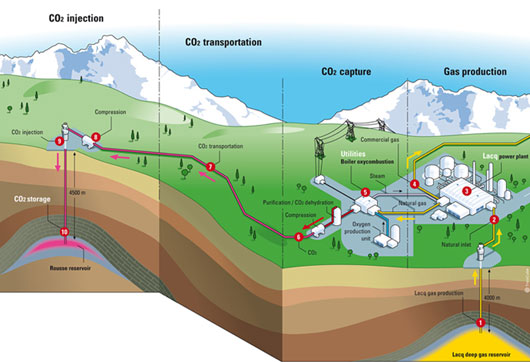
Too much carbon emissions warming up the planet? No problem: just bring the stuff back to where you got it from in the first place. Experts have been advising to bury carbon dioxide (CO2) for some time now and the technologies are maturing rapidly. Within Europe, the Dutch are seeking to take the lead and become the carbon collector for north West Europe.
Rotterdam – the Netherlands second largest city, home to Europe's biggest port and a major hub for oil, coal and biofuels – is counting on plans to capture and store CO2 in old gas fields so it can pursue industrial development and also meet ambitious targets to cut emissions by 2025.
The initiative, a platform for local authorities, groups and companies to work together to fight climate change, also wants to develop a Dutch system for CO2 transport and storage which could eventually serve the wider north west European region.
"Rotterdam is perfectly located to become a CO2 hub for north west Europe," said Maarten de Hoog from DCMR Milieudienst Rijnmond, an environmental protection agency for the area and a key member of the initiative.
"A lot of CO2 sources are close together here, so it is cheaper to connect them to one central system. Our industry is also near the sea which holds the most realistic option for large-scale storage," he said in an interview with Reuters.
Carbon capture and storage (CCS), which works by burying C02 deep underground, is seen by industry and some lawmakers as the most vital technology in the climate change fight as it could curb emissions from coal and other fossil fuel plants.
But it has never been tested on a commercial scale and is opposed by some environmentalists who argue it is unsafe, will not be ready in time and could divert investment away from truly green sources of power.
The Dutch government has invested 30 million euros (US$47.42 million) in pilot projects and has plans to commit a further 60 million euros by the end of the year, though the initiative says it will need a lot more to achieve its goals.
Much larger sums have been dedicated to the technology elsewhere in the world, for example, by the Canadian province of Alberta, which said this week it would put almost US$4 billion into funds to pay for CCS programs.
But members of the initiative say the Netherlands, owner of Europe's biggest natural gas field in Groningen, also has the potential to use its experience with gas to become a leader in CCS technology and infrastructure.
PLUG IN
"We have lived already for decades using gas and transporting gas, now we could bring it back as CO2," said Ruud Lubbers, chairman of the initiative. "In the next step, the Ruhr and Antwerp areas could plug into the Dutch system."
An initial project Rotterdam is mulling would be to extend a pipeline from Royal Dutch Shell's Pernis refinery to transport the CO2 to an almost exhausted natural gas field close to the town of Barendrecht.
This would help towards a target of 5 million tonnes of CO2 storage per year by 2015, which the initiative hopes to increase to 20 million tonnes a year by 2025.
That compares with total EU carbon dioxide emissions from power production in 2007 of about 1.5 billion tonnes, and Netherlands power production emissions of 59 million tonnes CO2.
Overall, the initiative aims to halve CO2 emissions in the Rotterdam area by 2025 compared to 1990.
"We could extend the infrastructure with pipelines either upgrading the system or building a new pipeline directly into the North Sea," said De Hoog. "The storage capacity is not a limiting factor."
Several other companies are also working on CCS projects in the Netherlands.
E.ON Benelux has a test facility at a Rotterdam plant and is investing a further 10 million euros in another project. Dutch state pipeline operator Gasunie and Germany's RWE also have a project in the port of Eemshaven.
Story by Reuters News Service. Via Beyond the Beyond.
Derek
And if you had a major CO2 leak, the death toll would be tremendous. As men, we tend to screw things up, even those of us with the best of intentions. Just saying its scary.
Posted on
Paula
But what will happen to the CO2 ones it is put under ground? Will it seep through the soil, will it surface, will it stay contained, is it actually contained at all, will it naturally transform into something not so harmfull again?
Posted on